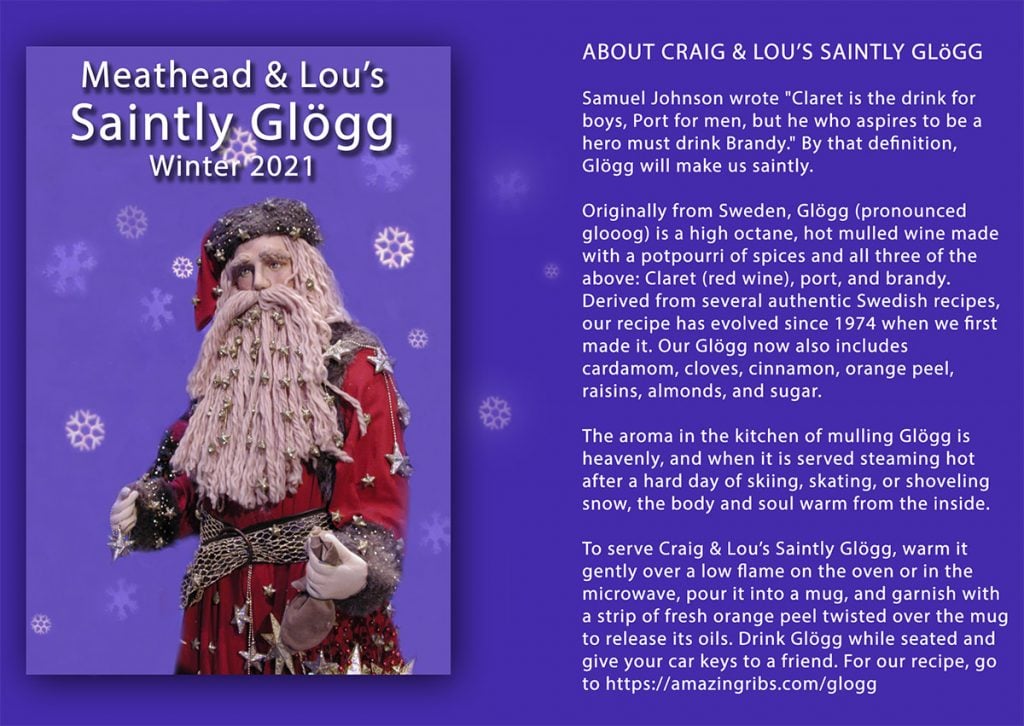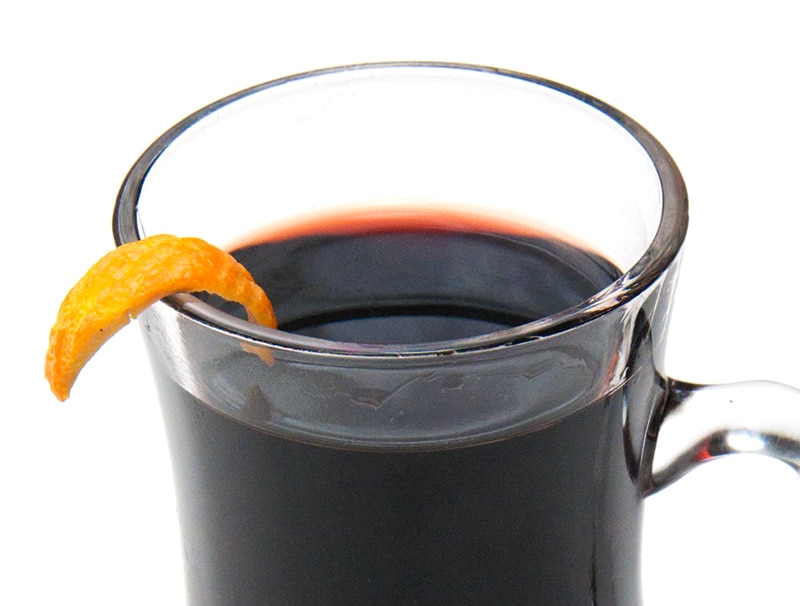“Claret is the drink for boys, port for men, but he who aspires to be a hero must drink brandy.” — Samuel Johnson
Samuel Johnson wrote the first English dictionary, so by his definition, Glögg will make us saintly.
Glögg, pronounced more or less like glooog, and means roughly “glow”, is a sweet, high-octane, mulled wine, which is to say it is made with a potpourri of spices and all three of the above: Claret (red wine), port, and brandy. Because it is served warm it is especially popular around Christmas. It is the perfect cold-weather drink, warming the body and soul from the inside out.
How does it work? The warm liquid raises the temperature of the mouth and stomach slightly, and because alcohol is a vasodilator, it forces blood to the skin, making us feel warm and blushing on the outside.
The Greeks and Romans were known to “mull” wine by adding spices to enhance its flavor and because it was thought to have health benefits. Probably because it was thought to be healthful, in a stroke of early marketing genius, English wine merchants in the 1500s named a spiced wine Hippocras after Hippocrates, the famous Greek physician who lived about 400 years BCE and is often referred to “the father of medicine.”
According to the Spirits Museum in Stockholm, King Gustav I Vasa of Sweden was fond of a drink made from German wine, sugar, honey, cinnamon, ginger, cardamom and cloves. It was later named “glödgad vin” in 1609, which meant “glowing-hot wine.” The word “glögg” is a shortened form that first appeared in print in 1870.
Its popularity spread throughout the European nations and in the 1890s it became a Christmas tradition. It was often used as a health potion, and I prescribe it for when you are motivated to shovel snow.
There are as many recipes for this old traditional winter beverage as there are for martinis. Instead of brandy, most Swedish recipes calls for aquavit, a distilled spirit frequently flavored with caraway seeds. Finnish gluggi often has vodka. Outside of Scandinavia, the Germans make a variation called glÙhwein (glow wine), often with a white wine base, and in Ireland it is made with (what else?) Irish whisky. In the US, I’ve tasted it made with bourbon. But I prefer the taste of glögg made with brandy.
The spices and flavorings change just as freely. Some people use dried cherries. Sugar content can be varied according to taste, and I have tasted it made with honey and maple syrup. Some brew it and drink it on the spot, and others age it. I usually do both. My wife and I like to make some for after dinner on Thanksgiving, and then we age some for Christmas and the rest of the winter. We have been making glögg since 1974 and refining the recipe since then. In 1979 I published my recipe in my column in the Chicago Tribune and that triggered many letters with new recipes, some aspects of which I have incorporated into the recipe below.
The aroma of mulling glögg is heavenly, and when it is served steaming hot in a mug after a hard day of skiing or shoveling the sidewalk, the body offers thanks. Glögg also makes a good marinade for beef or venison. Here is my tried and true recipe.
Makes:
Takes:
Ingredients
- 1.5 liter inexpensive dry red wine
- 1.5 liter inexpensive American port
- 750 ml inexpensive brandy
- 10 inches cinnamon sticks (10 inches total)
- 15 cardamom seed pods or 1 teaspoon whole cardamom seeds
- 24 whole cloves
- 1 washed orange peel
- ½ cup dark raisins
- 1 cup slivered almonds
- 2 cups sugar
- Garnish with the peel of another orange when serving
These recipes were created in US Customary measurements and the conversion to metric is being done by calculations. They should be accurate, but it is possible there could be an error. If you find one, please let us know in the comments at the bottom of the page
Method
- Prep. If you have whole cardamom seed pods, crack them open by placing a pod on the counter and laying a butter knife on top of it. With the palm of your hand, press on the knife. It will crack it open so the flavors of the seeds can escape. You can leave the seeds in the pods once they are cracked.
- Pour the red wine and port into a stainless-steel or porcelain kettle. Do not use an aluminum or copper pot since these metals interact with the wine and brandy to impart a metallic taste.
- Rinse the cinnamon, cardamom, cloves, orange peel, raisins, and almonds in a strainer to remove particles and dust. Add them to the pot, cover, and simmer. Try to get the orange peels skin down.
- Caramelize the sugar. Put the sugar in a pan and soak it with half the brandy. Warm over a medium-low flame and stir occasionally until it becomes a clear, golden syrup and all the sugar is dissolved. Let it simmer until it turns amber in color and hits 216°F (102.2°C). This starts caramelizing the sugar and adds a layer of flavor.

- Simmer the glögg. Add the sugar syrup to the spiced wine mix. Cover and let it simmer over a low heat for 1 hour.
- If you wish, add more sugar or brandy. If you do, go easy, 1/4 cup (50.2 g) at the most. As my barber says, "I can always cut more off but I can't put it back on". You can always add more brandy, but if you go over the top, you can't get back under.
- Strain. Strain to remove the spices, almonds, and raisins and then run the glögg through a coffee filter. This reduces the amount of sediment it throws and smooths the taste.
- Keep some solids. Do not discard the raisins and almonds when you are done. They are impregnated with flavor! I put the raisins in a jar in the refrigerator, and my wife bakes them into Panettone, King Cake, Challah, or Raisin Bread (after I snack down a few handfuls). I roast the almonds in a 225°F (107.2°C) oven for about 90 minutes and munch them as snacks.
- Bottle it. You can serve your glögg immediately or bottle it in clean used wine or whiskey bottles. We bottle it with the label shown here and if you are someone special to us, you might find a bottle under your tree. Fill the bottles as high as possible and seal them tight. Glogg really improves with age. It smooths out the rough edges and gives sediment time to drop to the bottom. A month or two of aging enhances the flavors and marries them beautifully. A year is even better. A good glögg will throw a thick purple sediment as it ages, but that doesn't become a problem for months. It's just normal settling of particulate matter held in suspension as well as compounds in the wine coming out of solution as they combine with oxygen in the aging process. Just pour gently and don't shake the bottle, and discard the sediment when you get to the bottom of the bottle. Tastes like mud.You don't have to lie them down to age. If you stop them up with used corks, they might leak where the corkscrew entered if you lie them down.

- Serve warm. To serve glögg, warm it gently in a saucepan over a low flame or in a microwave. For a crowd, warm it in a slow cooker. Serve it in a mug and, don't skip this: Garnish it with a strip of fresh orange peel, twisted over the mug to release the oils. Drink while seated and give your car keys to a friend.




High quality websites are expensive to run. If you help us, we’ll pay you back bigtime with an ad-free experience and a lot of freebies!
Millions come to AmazingRibs.com every month for high quality tested recipes, tips on technique, science, mythbusting, product reviews, and inspiration. But it is expensive to run a website with more than 2,000 pages and we don’t have a big corporate partner to subsidize us.
Our most important source of sustenance is people who join our Pitmaster Club. But please don’t think of it as a donation. Members get MANY great benefits. We block all third-party ads, we give members free ebooks, magazines, interviews, webinars, more recipes, a monthly sweepstakes with prizes worth up to $2,000, discounts on products, and best of all a community of like-minded cooks free of flame wars. Click below to see all the benefits, take a free 30 day trial, and help keep this site alive.
Post comments and questions below
1) Please try the search box at the top of every page before you ask for help.
2) Try to post your question to the appropriate page.
3) Tell us everything we need to know to help such as the type of cooker and thermometer. Dial thermometers are often off by as much as 50°F so if you are not using a good digital thermometer we probably can’t help you with time and temp questions. Please read this article about thermometers.
4) If you are a member of the Pitmaster Club, your comments login is probably different.
5) Posts with links in them may not appear immediately.
Moderators